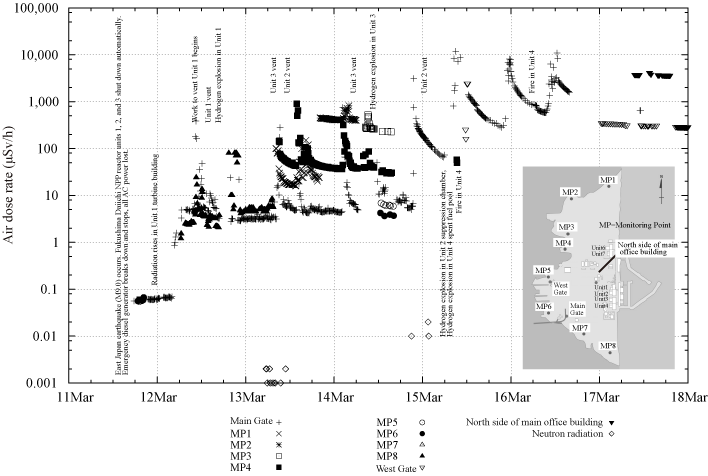The Fukushima Nuclear Disaster:
Evolution of the Crisis and Resulting Radiation Levels
The earthquake struck at 14:46 on March 11, 2011. The seismograph on the floor of the basement of Fukushima Daiichi Nuclear Power Station's containment building registered ground accelerations of up to 550 gals. Immediately afterward, online reactor Units 1, 2, and 3 went into emergency shutdown. Because the mammoth temblor toppled nearby transmission towers, the plant's external electricity supply was cut off, prompting emergency diesel generators to start up automatically.
The second wave of the quake-generated tsunami hit Fukushima I at 15:35. Tokyo Electric Power Company (TEPCO), which operates the plant, told a press conference that the wave - more than 7.5 meters high - was so large that it destroyed the installation's tidal monitoring equipment. At about 15:41, the diesel generators malfunctioned and shut down, depriving Fukushima I of all AC electrical power. Consequently, cooling pumps, vents, and other devices dependent on electricity stopped working.
By this time, irregularities, including a drop in reactor core water levels, were being observed. The high-pressure core flooder system, part of the emergency core cooling system, attempted to activate itself, but only the system in Unit 3 started successfully; the flooder equipment in Units 1 and 2 failed to operate (the high-pressure core flooder system is designed to operate on core-generated steam in the event of a shutdown).
In Unit 1, the emergency condenser was used to cool the core, and in Units 2 and 3, this task was performed by the reactor core isolation cooling system, but difficulties persisted in verifying that water was effectively reaching the core. The water-level gage in Unit 2 was broken, and for a period of time, the core water level could not be determined in that reactor.
While plant operators were preoccupied with Unit 2, conditions in Unit 1 deteriorated. At 23:00 on March 11, radiation levels in the Unit 1 turbine building soared, and at 00:30 on March 12, it was found that pressure inside the containment vessel housing the core had exceeded the maximum pressure the installation was designed to withstand.
Hydrogen Explosions Follow Containment Vents
TEPCO began contemplating the emergency venting of radioactive steam in the containment vessel in order to reduce the pressure inside. The objective was to prevent an excessive head of steam from rupturing the steel and concrete containment structure, but that would mean, in effect, destroying its primary purpose, which is to keep radioactivity inside the vessel, preventing its release into the atmosphere.
Between 05:00 and 09:00 on March 12, the water level in the Unit 1 core dropped precipitously, gradually exposing the fuel rods to air. It is thought that from this point onward, radioactivity was being vented continuously. According to measurements by TEPCO's monitoring car, 0.866 Sv/h were detected at the plant's main entrance at 04:40, and by 05:10, levels had reached 1.59 Sv/h, values 10 and 20 times higher, respectively, than normal.
At 14:30 on March 12, the vent on the Unit 1 containment vessel was activated, releasing a plume of radioactive steam into the atmosphere, and within a short period of time, there were reports that radioactive cesium had been detected in the air. One hour later, a hydrogen explosion occurred in the containment building of Unit 1.
At 02:45 on March 13, the high-pressure flooder system in Unit 3 came to a halt, gradually exposing the fuel rods, and the containment vessel vent was opened twice. At 11:01 on March 14, a hydrogen explosion took place in this unit as well.
At Unit 2, in the afternoon of March 14, water injection via the reactor core isolation cooling system came to a stop, and workers began pouring seawater into the core, but the water level could not be restored. On March 15 at 00:02, the vent was opened, and at 06:10, a second hydrogen explosion erupted inside the pressure suppression chamber. Four minutes later, a hydrogen explosion followed by a fire occurred at Unit 4. The cause was most likely uncovered spent fuel rods in the unit's cooling pool interacting with the air after water in the pool had evaporated.
The following figure summarizes the Fukushima nuclear disaster and the contamination of the plant and surrounding areas by growing levels of radioactivity.
Chihiro Kamisawa (CNIC)


